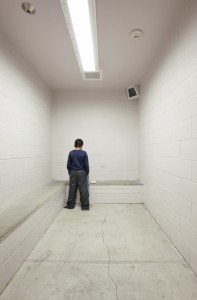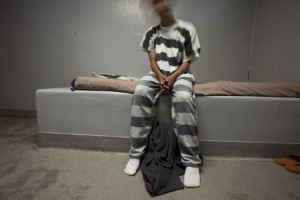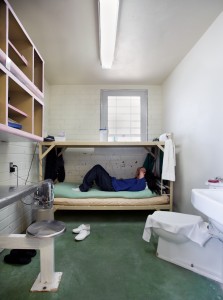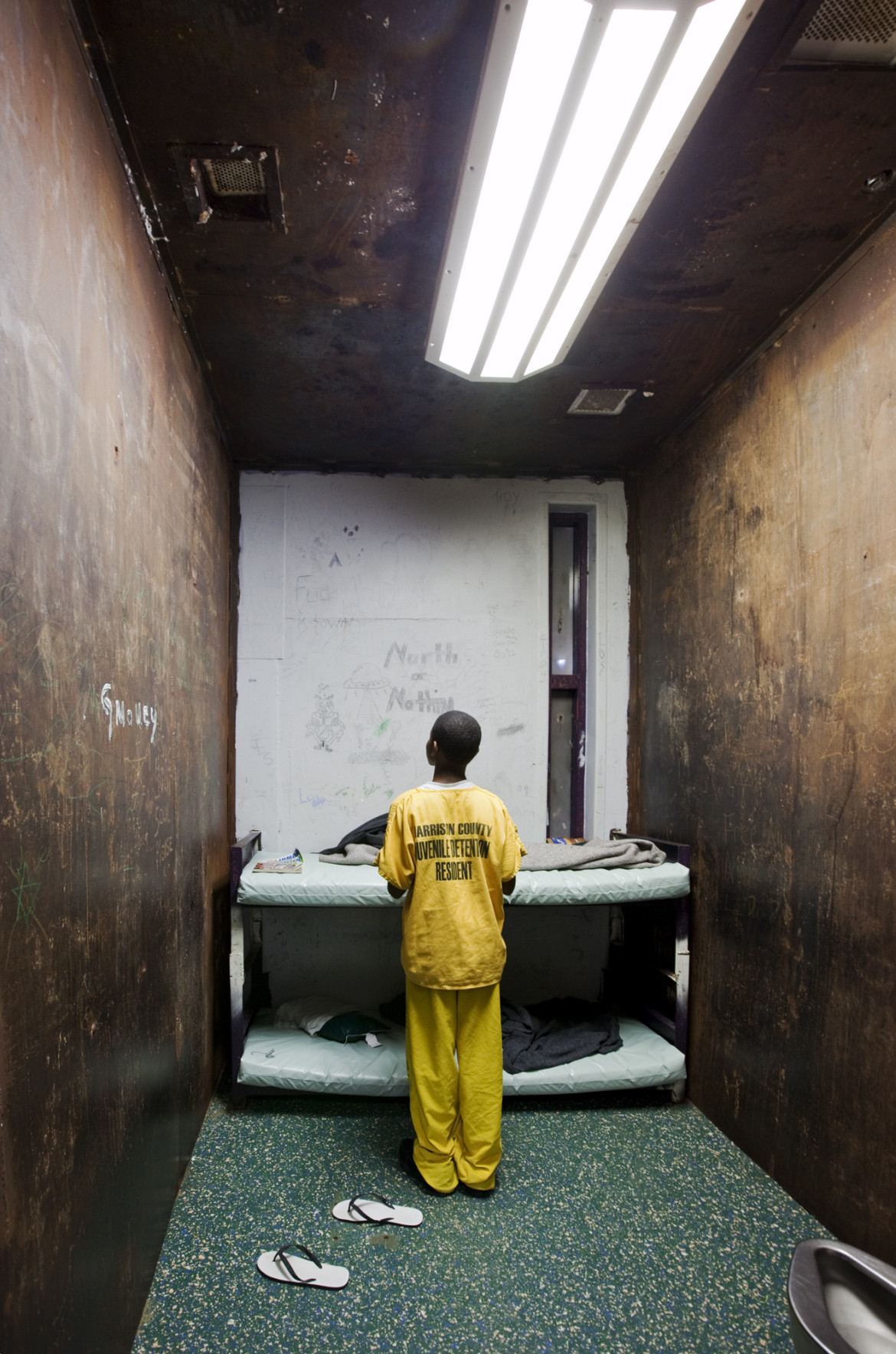
Juvenile-in-Justice, an exhibition of 50 large-scale color prints by award-winning photographer Richard Ross, will open at the Sturgis Library Art Gallery at Kennesaw State University, in Kennesaw, Ga., on Oct. 9, 2012. Ross’s photographs, based on five years of work interviewing and photographing young people involved in the juvenile justice system, document the realities of life in juvenile justice facilities across the country.
The young people featured in these photographs have different levels of involvement in the criminal justice
system—some have been tried and convicted, while others are being held in detention while waiting for the gears of the system to turn. A variety of settings are also featured, from segregation cells to recreation areas.
And yet, the overriding impression in these photographs is the depressing sameness of the facilities. Their dominant colors range from grey to beige, with concrete blocks a primary structural element. When bright colors appear in these photos, they often seem out of place, as if a kindergarten classroom had been converted overnight into a juvenile detention facility.
You seldom get a complete, unobscured view of a subject’s face in these photographs. Instead, they are seen from the back, at long distance or in extreme close-up, or their faces are partially cropped out of the frame, blurred by motion or hidden behind their hands or hair. This approach serves the obvious purpose of protecting the privacy of the individuals pictured, but it also serves a larger purpose. When you can’t see exactly who each subject is, they become young everymen and everywomen—not a particular kid locked up in a cell, but a young person not that dissimilar from your kids, your nieces and nephews, or the neighbor kids. It’s easy to forget about juveniles who become involved with the justice system, as long as you’re sure it has nothing to do with you and yours. Ross’ photos don’t allow you to erect that kind of barrier between his subjects and yourself.
from the back, at long distance or in extreme close-up, or their faces are partially cropped out of the frame, blurred by motion or hidden behind their hands or hair. This approach serves the obvious purpose of protecting the privacy of the individuals pictured, but it also serves a larger purpose. When you can’t see exactly who each subject is, they become young everymen and everywomen—not a particular kid locked up in a cell, but a young person not that dissimilar from your kids, your nieces and nephews, or the neighbor kids. It’s easy to forget about juveniles who become involved with the justice system, as long as you’re sure it has nothing to do with you and yours. Ross’ photos don’t allow you to erect that kind of barrier between his subjects and yourself.
The captions give you more of the details about the kids involved, and they’re often more shocking than the photos. The young man in prison stripes (outlawed as dehumanizing in some states over 100 years ago)? He’s 14 years old, “low functional” and spends most of his time sitting in his cell. That kid standing with his back to you, at the far end of his cell? He’s 10 years old, stabbed a classmate in school, and is waiting for his mother to get off work so she can come and get him. The girl covering her face with her long blonde hair? She’s 15 and is in for “partying and truancy”; she also uses meth.
Ross highlights the hard geometrical features of the detention facilities, finding a strange, abstract beauty in  their square lines and patterns. The uniformity of the windowless cells pictured in a group of eight identically-framed photographs, shot between 2008 and 2010 in five facilities in four different states, serves to highlight the small differences—the shape of the ceiling fixtures, whether the bed is free-standing or built into the wall—but this contemplation of form and line comes to a halt when you realize that a series of young human beings will call those cells home, possibly for an extended period of time.
their square lines and patterns. The uniformity of the windowless cells pictured in a group of eight identically-framed photographs, shot between 2008 and 2010 in five facilities in four different states, serves to highlight the small differences—the shape of the ceiling fixtures, whether the bed is free-standing or built into the wall—but this contemplation of form and line comes to a halt when you realize that a series of young human beings will call those cells home, possibly for an extended period of time.
Ross’ work has similarities with many documentarians, from the turn-of-the century social reformer Jacob Riis to the contemporary human rights photographer Fernando Moleres. But I see a particularly strong kinship between Ross’ work and that of Shelby Lee Adams, a contemporary photographer famous for his portraits of Appalachian families. While there are many superficial differences—Adams always shows the face of his subjects, places them in rich environments, and works primarily in black and white—on a deeper
level there’s a strong correspondence. Like Adams, Ross’ photographs are always carefully arranged, with full awareness of the context in which his subjects live and with particular effort to finding visual details that tell you who they are. Equally important, Ross, like Adams, honors the individuality and dignity of his subjects, and brings the experience of their lives to a public who might otherwise be aware of their existence.
tell you who they are. Equally important, Ross, like Adams, honors the individuality and dignity of his subjects, and brings the experience of their lives to a public who might otherwise be aware of their existence.
We’re constantly bombarded by visual information, so much so that it’s really difficult for any visual artist to grab your attention and make you think. Richard Ross is one photographer who can do just that—the photographs of Juvenile-in-Justice will linger in your mind long after you have left the exhibit, and I doubt you will ever think of kids in trouble the same way again.
The exhibition Juvenile-in-Justice is co-hosted by Kennesaw State University, the Center for Sustainable Journalism, and the Society of Professional Journalists, and will be on display in the Sturgis Library Art Gallery from Oct. 9 to Nov. 1, 2012. Ross will give a public lecture on Oct. 9, 2012, at 5 p.m. in the Prillaman Hall Auditorium, followed by an opening reception in the Sturgis Library Art Gallery. Learn more here and tell your friends.
Photos by Richard Ross.
